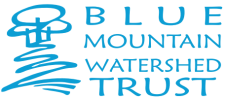-
OUR WATERSHEDS
The Blue Mountains Watersheds
Contents
Our Watersheds
What is a watershed? It is the area that captures precipitation and springs from groundwater, channelling all water towards one watercourse. In southern Georgian Bay, we are in the Great Lakes Watershed, of which a subset is the Blue Mountain Watershed. Within that watershed, we have eight distinct watersheds.
The importance of watersheds
The places where water flows and accumulates, like creeks, rivers and wetlands, are where nature can be founds at its most prolific. Fish, their avian and mammalian predators, as well as amphibians, reptiles and animals and birds of all kids congregate along watercourses and in wetlands. Watercourses have always acted as wildlife corridors. If we can keep them forested and pristine, they will continue to do so. If deer get trapped in non-contiguous wildlife areas, for example, they can get wiped out. Forest cover is also very important to keep water cool enough for game fish. Official plans speak to this fact, but it is not something that is put into practice. See the 2010 Collingwood Natural Heritage Systems Study, for example.
Wetlands help keep Georgian Bay healthy. They absorb flow during storm events, capturing and settling silt and waterborne pollution from entering the Bay. They break down toxins and clean our water. When wetlands are removed, dealing with water flow becomes an expensive engineering problem. The Minesing Wetland, for example, has been evaluated as being worth the equivalent of $167 million in engineering. And that’s just the value of the water management, never mind water purification and preservation of wildlife. Wetlands also act as an important recharge station for migratory birds.
A good rule of thumb is: The more development, the more paving, the greater the stormwater runoff and intensity.
How does your area measure up?
What nearby development proposals or current land uses are affecting your ability to enjoy the beauty of your area? That’s what the Blue Mountain Watershed Trust takes an interest in: protecting our remaining natural places.
Your actions impact our watersheds
When rain falls on your home, where does it go? For example, a house in Clarksburg might drain their rain water from their yard to their residential street sewer, to the main storm sewer on Marsh Street, to the main branch of the Beaver River, to Georgian Bay/Lake Huron, to Lake Erie, to Lake Ontario, to St. Lawrence River and finally to the Atlantic Ocean. What is your watershed “address?” Do you mow down to the edge of a local creek? Think about how you can minimize negative impacts on your watershed.
From the Beaver River to the Batteaux Creek, we are working hard to protect nature’s beauty in South Georgian Bay. Have a look at the map below to locate our watersheds and to see some of the activity happening in and around them.
Please note: subwatershed areas provided by NVCA (Nottawasaga Valley Conservation Authority) and GSCA (Grey Sauble Conservation Authority) are for informational purposes only.
If your browser does not support the above Google Maps image, click here for a downloadable image of our subwatersheds.
Watch this quick videos from the Ontario Headwaters Institute to learn more about watersheds and how their protection is important to our well-being:


